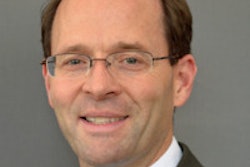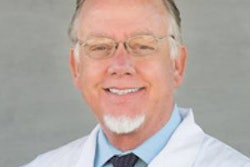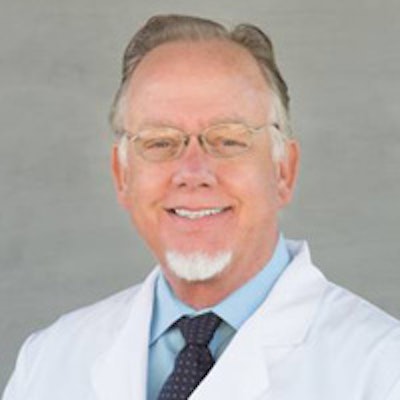
Most patients appreciate offices that are technologically up-to-date. And I, like most dentists, have diligently added new services as they became available.
It is fair to say that the patients I have treated for decades have benefited from strategic introduction of new options. The introduction of these new options is based partially on the history of outcomes noted for patients under my care.
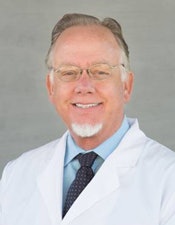 Tom Cockerell Jr., DDS, is the CEO of Dental Symphony.
Tom Cockerell Jr., DDS, is the CEO of Dental Symphony.My restorations used to be created digitally by scanning models poured from an analogue impression. Recognizing the mismatch of technologies, I transitioned to digital impressions as soon as I could. The digital-to-digital workflow makes more sense and has an expected better outcome in many respects.
Along with providing modern clinical choices, our office has offered a "risk-based" preventive dental program that emphasizes keeping dental caries at bay and knowing if the periodontal attachment position is changing relative to the cementoenamel junction (CEJ). Screenings for oral cancer, mucosal lesions, bone lesions, managing trauma, dental care phobia, and complex medical histories are part of the full spectrum of services.
I suggest there are advantages for patients to stay with one dentist as long as possible because of the insight gained from the continuity of care and evolving deep understanding of the patient's clinical history, needs, and outcomes.
But I wish I had more to offer.
I wish I could have collected and used ongoing data to create a big-picture view of all the clinical parameters that are of interest. This would allow us to see trends and understand better why and when treatment may be required.
What are those clinical parameters that could be presented in a unique way and analyzed for trends? Here are some examples:
- Recall appointment compliance
- Plaque score noted at each appointment
- Gingival bleeding score noted at each appointment
- Periodontal pocket development over time
- Periodontal clinical attachment position over time
- Caries incidence
- Restorative history
- Recurrent caries history
- Tooth loss history
- Salivary quality and quantity
- Tobacco use
- Use of xerostomia-inducing drugs
- Caries risk assessments
- Periodontal disease risk assessments
- Suspicious lesion monitoring
- Detection of cervical lesions
- Presentation of root surface caries
- Bruxism-related changes
- Malocclusion
- Periods of inadequate home care related to an episode or issue
- Changes in preventive recall periodicity
- Entry into a practice protocol
- Change in choice of restorations
- Orthodontic care period
- Fluoride in the water or not
- Disease diagnosis
The chart below shows how these could be presented.
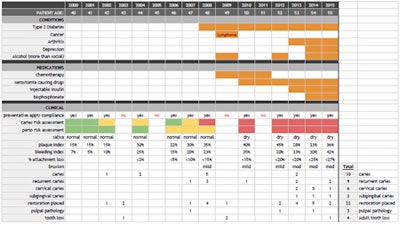
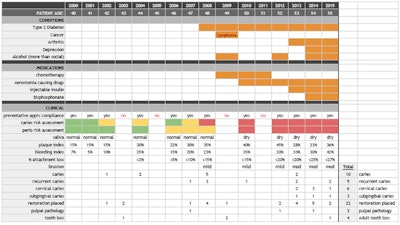
A sample chart of a patient's clinical parameters.
Sophisticated software is required to do this. Surprisingly, it is still not available. Imagine how helpful this would be for long-term relationship care.
It should be pointed out that there is no research that proves the clinical information presented in the table is useful except in making assumptions. But wouldn't it be great if research could be done so that algorithms could be created that weigh the clinical parameters to present an overall clinical picture.
This software would then automatically tap into evidence-based research protocols seeking better outcomes. Also being able to move a patient from one practice to another without loss of data for suitable trend analysis surely must be a goal.
Let's think together about the situation when a patient moves from one dentist to another. Imagine receiving a new patient's record accompanied by the example chart shown above and a letter from the previous dentist that states:
Thank you for continuing the care for Jane Doe. Jane has been a patient of mine for 15 years. You will observe that Jane is struggling with chronic periodontitis and is losing clinical attachment. She also has high caries risk and has begun developing subgingival caries. The implications of her medical history and pharmacology induced oral reactions that began in 2010 are notable. Unless there is a change in trends, Jane should be considered for implant/prosthetic therapy. Preventive dental disease protocols recommended by the ADA have been followed for two years, and Jane's profile is followed by a research group at the University of Somewhere Dental School under the guidance of Dr. Good Doctor for regenerative hard and soft tissue. Jane's clinical data are scheduled for review by the Metro Clinic Dental Informatics Center for contributing evidence-based guidelines for her continued care related to the impact of her medications on her oral health. Please contact staff at that institution for next steps.
If I can provide further information, please do not hesitate to contact me. These records will merge directly into your software so that no loss of continuity is experienced.
Wouldn't you be impressed and wouldn't this help you understand how best to help your new patient?
Remember, we won't have these software features until we expect them. The legacy of software is financial management/insurance processing and appointment books, and the added-on clinical functionality has not changed much in decades. While you can put information into a patient electronic record, features that enable the process of clinical thinking and patient management have not advanced measurably.
As new features are developed, we need to ensure that clinician's input design them by pointing out to vendors what would be helpful. Being able to better discern trends in any patient for which data have been accumulated is important.
Tom Cockerell Jr., DDS, is in private practice in Fort Worth, TX. He is the CEO of Dental Symphony.
The comments and observations expressed herein do not necessarily reflect the opinions of DrBicuspid.com, nor should they be construed as an endorsement or admonishment of any particular idea, vendor, or organization.




